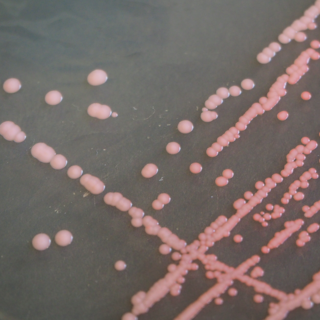Pseudarthrobacter chlorophenolicus is a species of bacteria capable of degrading high concentrations of 4-chlorophenol, hence its name. As such, it may be useful in bioremediation.
Glutamicibacter soli is a species of Gram-positive bacteria.
Paeniglutamicibacter cryotolerans is a species of bacteria. It is psychrotolerant, halotolerant, Gram-positive, motile, and facultatively anaerobic. It possesses a rod–coccus cycle.
Paeniglutamicibacter antarcticus is a species of bacteria. It is Gram-positive, motile, aerobic and has a rod–coccus cycle.
Pseudoglutamicibacter cumminsii is a species of Gram-positive bacteria.
Paenarthrobacter aurescens is a bacterium species from the genus Paenarthrobacter . Paenarthrobacter aurescens produces nitrilase and L-N-carbamoylase. Paenarthrobacter aurescens has a low GC-content and has the ability to utilize anethole.
Pseudarthrobacter defluvii is a bacterium species from the genus Pseudarthrobacter which has been isolated from sewage from the Geumho River near Daegu, Korea. Pseudarthrobacter defluvii has the ability to degrade 4-chlorophenol.
Paenarthrobacter histidinolovorans is a bacterium species from the genus Paenarthrobacter which has been isolated from soil. Paenarthrobacter histidinolovorans produces histidinol dehydrogenase.

Paenarthrobacter nicotinovorans is a Gram-positive and aerobic bacterium species from the genus Paenarthrobacter. This bacterium has the ability to degrade atrazine, nicotine, and creatine. and produces nicotine dehydrogenase
Glutamicibacter protophormiae is a bacterium belonging to the genus Glutamicibacter. It contains a glycolipid 3-[O-α-D-mannopyranosyl-(1→3)-O-α-D-mannopyranosyl]-sn-1,2-diglyceride (DMDG). It has peptidoglycan type A4α with a bridge of (Lys–Ala–L-Glu). It has unsaturated menaquinones, dominated by MK-8. It does not contain the lipid phosphatidylinositol.
Paenarthrobacter is a genus of bacteria from the family Micrococcaceae.
Paenarthrobacter ureafaciens is a bacterial species of the genus Paenarthrobacter. Polar lipid profile of this species is an unknown.
Paeniglutamicibacter gangotriensis is a bacterium from the genus Paeniglutamicibacter which has been isolated from soil from the station Dakshin Gangotri in Antarctica.
Paeniglutamicibacter psychrophenolicus is a Gram-positive, non-spore-forming, aerobic, rod-coccus, facultatively psychrophilic and non-motile bacterium from the genus Paeniglutamicibacter which has been isolated from an alpine ice cave in Salzburg, Austria.
Paeniglutamicibacter sulfureus is a bacterium from the genus Paeniglutamicibacter which has been isolated from oil brine.
Glutamicibacter ardleyensis is a psychrotrophic and rod-coccus bacterium from the genus Glutamicibacter.
Glutamicibacter arilaitensis is a bacterium from the genus of Glutamicibacter which has been isolated from Reblochon cheese from France.
Glutamicibacter creatinolyticus is a Gram-positive, non-spore-forming and aerobic bacterium from the genus Glutamicibacter which has been isolated from human urine in Japan.

Arthrobacter bussei is a pink-coloured, aerobic, coccus-shaped, Gram-stain-positive, oxidase-positive and catalase-positive bacterium isolated from cheese made of cow´s milk. A. bussei is non-motile and does not form spores. Rod–coccus life cycle is not observed. Cells are 1.1–1.5 µm in diameter. On trypticase soy agar it forms pink-coloured, raised and round colonies, which are 1.0 mm in diameter after 5 days at 30 °C The genome of the strain A. bussei KR32T has been fully sequenced.
Pseudarthrobacter is a genus of bacteria from the family Micrococcaceae.

